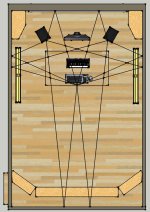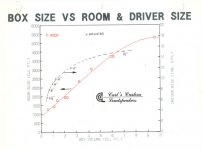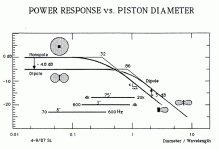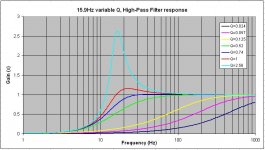The test signal is a low frequency sweep (it's really a freq response measurement driven by a sine sweep) on the Adjust+ test record.
The test signal sampled at 44.1k/24 but I will redo it at 96k/24 when I get some time.
Thank you Jan.
I thought that it was an FFT based test and I asked for the frequency resolution (FFT size).
You don’t have to do a resampling. It will not change anything.
If the arm would be too heavily damped, wouldn't I see still some resonance of the cartridge?
No. See the attached example from a 15.9Hz filter.
Below a Q= 0.5, you can not be certain where is the resonance frequency of the filter.
There is a separate test for the arm alone, which normally resonates at several 100 Hz. See example of the same arm.
These are the various sub mass systems resonating. Very useful test.
George
Attachments
the concept of LEDE is pretty much dead in the pro world as it was originally defined. Control is now the better definition of the design criteria. Much of the information that was learned by designing LEDE rooms is included in todays mindset, but it is expanded to be more informed beyond that.
Thomas Northward has interesting ideas and has designed some interesting rooms, I have had the opportunity to hear two of them and he has designed good working rooms with the physical limitations given. One was in Brooklyn so space is expensive and it is small, but sounded good, a hard job to pull off.
Generally one of the things most designers are looking for today is symmetry in a room, especially in the area where the speakers emanate from. Then, any anomalies or fixes are heard/applied equally to both channels for stereo. More desirable for good spatial reproduction and phase delay symmetry.
Then, which room are you trying to emulate? The recording studio or the Mastering Room, usually very different environments. Many of today's mastering rooms are more like very highly defined listening rooms. Uniform dispersion of reflected sound, good dampening of low end, etc.
Alan
Thomas Northward has interesting ideas and has designed some interesting rooms, I have had the opportunity to hear two of them and he has designed good working rooms with the physical limitations given. One was in Brooklyn so space is expensive and it is small, but sounded good, a hard job to pull off.
Generally one of the things most designers are looking for today is symmetry in a room, especially in the area where the speakers emanate from. Then, any anomalies or fixes are heard/applied equally to both channels for stereo. More desirable for good spatial reproduction and phase delay symmetry.
Then, which room are you trying to emulate? The recording studio or the Mastering Room, usually very different environments. Many of today's mastering rooms are more like very highly defined listening rooms. Uniform dispersion of reflected sound, good dampening of low end, etc.
Alan
The listening room was chosen to have irregular shape and large volume and a balance with absorption... ceiling is high so there is no early bounce off that.... ceiling is unpainted red wood boards covering 100%. Floor is a honey-comb concrete (no vibration) with 2-3cm of pad and rug covering 80%. additional hidden absorption panels around the room. low freq are supported by driving the speakers into the room length. I sit near middle and close to speakers.
THx-RNMarsh
Richard,
Very interesting my listening room is 5' shorter in virtually every dimension.
Ceiling has 6qty x 6" x 6" beams running crosswise or down hill.
Full brick wall, Tall to short side where the speaker's are. Opposing short wall
(behind where one would sit, are built in wooden cabinets.
Walls are texture over wall board, Six large 4' x 7' windows along one
wall with louvers and heavy drapes. The opposing long wall is split
in the center with a 4' walk way. The close section to speakers has a very
large wall hanging "treatment" approx 2 inches standing off the wall.
It is a traditional heavy tapistry from Belgium 2 m x 3 m. The wall on
the other side of the walk way has a 3' x 3' cut out centered upon it.
Followed by two additional walk ways at that end corner.
The house is pier and beam then laid with concrete, then with brick in a 2 brick
by 2 brick cross hatch pattern.
The floor in front of the speakers is covered with a large thick wool rug
approx 1/2 to 3/4 inch thick, 8 x 10 feet.
Currently the speakers are pointing long wise at a about 55 - 60 degree
angle from the corner of the room. I've got a kid now, so I have to keep
it pretty open.
I used to have the speaker pulled off the wall about 1 foot. Then to balance
out the sound I moved the speaker on the tall side of the room about another
1 to 1.5 foot towards the center of the room. It sounded very good like that
and imaged like crazy.
How do you have your speakers oriented?
Last edited:
Wow Esperado, typically here in the states, guns and beer don't mix,
the guy in the armory about 1/2 way through is pointing to a rack
of guns and rifles with a beer?
Funny thing,
Of course they accepted my application and wanted me to drive V.I.P.s. In addition they wanted a $335.00 fee for the official volunteer T-shirts.
Simon,
Are you an I.A.T.S.E. brother?
Cheers,
LEDE rooms is included in todays mindset, but it is expanded to be more informed beyond that.
Generally one of the things most designers are looking for today is symmetry in a room, especially in the area where the speakers emanate from. ....... More desirable for good spatial reproduction and phase delay symmetry.
Then, which room are you trying to emulate?
Alan
I have been in plenty of studios and few have a lock on perfection. Including the hard to get invited to... Lucus Films studio (name dropping to tweek Waly).
Reduction of early reflections and Near-field are two of the key words in playback. Of course symetry is a requirment... always has been.
For a circuit or system which displays low group delay, near-field and controlled dispersion allows full benefit in listening.
So FIR is the better way to do a filter for low GD for low freqs?? HP filter.
Who has done this already for TT/LP?
THx-RNMarsh
This is what I do.... not a control room but it works well....
 Actually the speakers are close to the wall but fig-8 flat panel speakers are not. The spkers are not wide dispersion type.
Actually the speakers are close to the wall but fig-8 flat panel speakers are not. The spkers are not wide dispersion type.
For such a large volume space, I need bass speakers of adequate size et al --- if your listening vol falls within these parameters, this might be useful rough guide.


THx-RNMarsh
 Actually the speakers are close to the wall but fig-8 flat panel speakers are not. The spkers are not wide dispersion type.
Actually the speakers are close to the wall but fig-8 flat panel speakers are not. The spkers are not wide dispersion type.For such a large volume space, I need bass speakers of adequate size et al --- if your listening vol falls within these parameters, this might be useful rough guide.


THx-RNMarsh
Last edited:
That's a pretty decent article.
The earliest "cooled termination" approach is I believe from W. S. Percival in Wireless Engineering, Vol. 16, 237, 1939, followed by a slightly more scholarly discussion in Strutt and van der Ziel, Physica, Vol. 9, 513, 1942. It is also discussed in van der Ziel, Noise, Prentice-Hall, 1954, pp. 281-283.
The cooled termination approach amounts to a negligible noise reduction for MC cartridges, given their low inductance. Applied to the Cordell approach to realizing (most or all) of the 75us tau rolloff by a stiffish loading of a MM cartridge, it can assist that a good deal---but you have to know the cartridge inductance accurately.
As to still-better topologies, certainly lower noise and large overload margins can be pursued, but I'm not ready to discuss these at the moment.
Brad
Simon,
Are you an I.A.T.S.E. brother?
Cheers,
No.
The last IATSE crew I hired backed a lift into a seating riser collapsing it. As it was precast concrete installed with a crane before the roof was finished it looked like it would be in the millions to replace.
Fortunately the owner accepted a repair involving adding steel supports. Ended up costing under $50,000.
Richard,
Very interesting my listening room is 5' shorter in virtually every dimension.
The floor in front of the speakers is covered with a large thick wool rug
approx 1/2 to 3/4 inch thick, 8 x 10 feet.
Currently the speakers are pointing long wise at a about 55 - 60 degree
angle from the corner of the room.
I used to have the speaker pulled off the wall about 1 foot. Then to balance
out the sound I moved the speaker on the tall side of the room about another
1 to 1.5 foot towards the center of the room. It sounded very good like that
and imaged like crazy.
How do you have your speakers oriented?
I have them across the width (but not at the corner) and shoot down the length.
Did you ever get a chance to measure the reverb decay times of the room?
-Richard
Then, which room are you trying to emulate?

Recording Studio Design: Philip Newell: 9780240522401: Amazon.com: Books
Dimitri
Thank you for the link
George
It's a good idea to have his house build by a movie's crew . They can do-it in only one day.The last IATSE crew
You just have to like expanded polystyrene walls, windows that open onto the walls, doors that do not open at all, stairs that collapse under your weight, painting flowing at the first rain.
Yes, a good idea ;-)
I am always affraid, when i look the families entering in their new home build by "Extreme Makeover". I believe the familly members are all stunts with a solid insurance ?
I have been in plenty of studios and few have a lock on perfection. Including the hard to get invited to... Lucus Films studio (name dropping to tweek Waly).
As a name drop that is a horrendous bag of fail. Firstly its Lucasfilm (one word and has been since I was in shorts). Secondly the place to go for sound is the Skywalker ranch, where skywalker sound is based.
So I doubt Waly will be tweaked at all.
Dimitri,I was just reading up on you rumble HP filter. Most of my measurements show a 0.55Hz speed modulation from the record eccentricity and/or the spindle being too small diameter. I thought that this would cause an FM modulation on the signal rather than an AM modulation. So I wonder whether a HP would help with this?
Jan
The resonance is always where phase is 90 deg, even when the system is heavily damped with no clear peak this remains true.Below a Q= 0.5, you can not be certain where is the resonance frequency of the filter.
Ironically, |group delay| at any frequency decreases with more damping, despite phase and frequency response artefacts progressively worsening within the audio band. Just another demonstration of the uselessness and misapplication of group delay as a figure of merit in audio.............
Lucky, that is an interesting thought about group delay. An additional argument to use a different metric.
Your remark about resonance, isn't that only true for a 2nd order system? For example, a bass reflex enclosure - 4th order - has 180 degrees phase shift at resonance.
Your remark about resonance, isn't that only true for a 2nd order system? For example, a bass reflex enclosure - 4th order - has 180 degrees phase shift at resonance.
That is good explanation...across the width and shoot down the length...I have them across the width (but not at the corner) and shoot down the length.
Did you ever get a chance to measure the reverb decay times of the room?
-Richard
as are mine.
I tried some of the high end Maggies, oriented along the length but shooting to
the tall side of the room. It would shimmer. I tried two Citation IIs as mono
blocks that didn't work out much either. Then I found two of the Mesa
Boogie 190 bass amps (they only made 100 of them) and ended up
tri amping, 190 bass, 190 bass and then used one of the Citations in stereo
for the mids/highs.
I had two active cross overs to dial it in. But it never sounded good to me
so I sold them.
I don't know how to do a reverb measurement. Pointers would be
helpful. Maybe in audio cyclopedia?
Listening to Chris Isaac, Heart Shaped World, track 5 wicked game, 6 blue
spanish sky, and Jungle Heat track 10. followed by Brothers in Arms, and
Jeff Buckley, Hallelujah. I'd finish with KDLang Ingenue but the kid ran off with the disc, that's my story and sticking too it.
A bit of Gov't Mule Live a little help with our friends....
Now I really want to hear some Marshall Tucker....
spent a $ 100 and go to Dallas.
I wonder those would it sounds in HD sound with subs?
Firstly its Lucasfilm (one word and has been since I was in shorts).
Oh my bad, I always thought it was "Lucasfilm, Ltd."
But if you are buying Ale, we'll call it (a) "Lucasfilm, Pty."

As we used to say, collective groan please,
It's close enough for government work.
- Status
- Not open for further replies.
- Home
- Member Areas
- The Lounge
- John Curl's Blowtorch preamplifier part II
